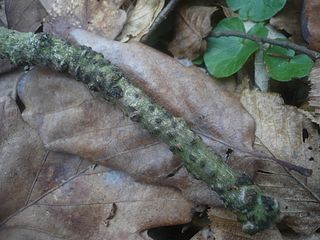Related Research Articles
Gordon Herriot Cunningham, CBE, FRS was the first New Zealand-based mycologist and plant pathologist. In 1936 he was appointed the first director of the DSIR Plant Diseases Division. Cunningham established the New Zealand Fungal Herbarium, and he published extensively on taxonomy of many fungal groups. He is regarded as the 'Father' of New Zealand mycology.

Fungal infection, also known as mycosis, is a disease caused by fungi. Different types are traditionally divided according to the part of the body affected; superficial, subcutaneous, and systemic. Superficial fungal infections include common tinea of the skin, such as tinea of the body, groin, hands, feet and beard, and yeast infections such as pityriasis versicolor. Subcutaneous types include eumycetoma and chromoblastomycosis, which generally affect tissues in and beneath the skin. Systemic fungal infections are more serious and include cryptococcosis, histoplasmosis, pneumocystis pneumonia, aspergillosis and mucormycosis. Signs and symptoms range widely. There is usually a rash with superficial infection. Fungal infection within the skin or under the skin may present with a lump and skin changes. Pneumonia-like symptoms or meningitis may occur with a deeper or systemic infection.

A leaf spot is a limited, discoloured, diseased area of a leaf that is caused by fungal, bacterial or viral plant diseases, or by injuries from nematodes, insects, environmental factors, toxicity or herbicides. These discoloured spots or lesions often have a centre of necrosis. Symptoms can overlap across causal agents, however differing signs and symptoms of certain pathogens can lead to the diagnosis of the type of leaf spot disease. Prolonged wet and humid conditions promote leaf spot disease and most pathogens are spread by wind, splashing rain or irrigation that carry the disease to other leaves.
Phytophthora citricola is a plant pathogen. It was first described by Kaneyoshi (Kenkichi) Sawada in 1927 when it was isolated from orange trees in present-day Taiwan. It has since been found causing disease on a wide variety of plants.

Pythium debaryanum is a species of water mould in the family Pythiaceae. It is known as a plant pathogen on many kinds of wild and cultivated plants, including peanut, beet, eucalyptus, tobacco, and pine trees. The plants develop damping off, a disease state.
Olpidium brassicae is a plant pathogen, it is a fungal obligate parasite. In 1983, the Alsike, Alberta area's clover was struck by a fungus epidemic of Olpidium brassicae, previously not seen in Canada.

Stigmina carpophila is a fungal plant pathogen causing shot hole disease in stone fruits.

Verticillium albo-atrum is a plant pathogen with many hosts.
Ramularia necator is a fungal plant pathogen infecting coconut palms.
Fusarium oxysporum f.sp. lini is a fungal plant pathogen. Among the diseases it causes is flax wilt.
Elsinoe rosarum, Anthracnose, is a fungal plant pathogen. It is a condition found on roses, causing leaves to have irregular dark margins and spots. The disease usually appears during wet weather.

Asperisporium caricae is an ascomycete fungus that is a plant pathogen, found in North and South America. It is responsible for the black spot disease on papaya trees. It affects generally leaves and fruits at any time. Sporodochia of Asperisporium caricae was growing under side of leaf, dark blackish brown to black, stroma well-developed, erumpent.
Periconiella cocoes is an ascomycete fungus that is a plant pathogen affecting the coconut.
Phoma tracheiphila is a fungal plant pathogen. It causes a disease known as Mal secco on citrus trees. It occurs in dry, cool climates such as the Mediterranean, Black Sea and Asia Minor. It forms pycniospores that are carried short distances by rain, or by wind to new leaves, where germinated hyphae invade stomata or more likely fresh wounds.

Valsaria insitiva is a plant pathogen, that causes perennial canker in apples and almonds.
Phyllosticta concentrica is a fungal plant pathogen.

Fusarium oxysporum f.sp. lycopersici is a fungal plant pathogen. It is a big pathogen to the tomato plant. It has a violet to white color on most media but does not produce a pigment on King's B medium.
Pathogenic fungi are fungi that cause disease in humans or other organisms. Although fungi are eukaryotic, many pathogenic fungi are microorganisms. Approximately 300 fungi are known to be pathogenic to humans; their study is called "medical mycology". Fungal infections are estimated to kill more people than either tuberculosis or malaria—about two million people per year.

A fungus is any member of the group of eukaryotic organisms that includes microorganisms such as yeasts and molds, as well as the more familiar mushrooms. These organisms are classified as one of the traditional eukaryotic kingdoms, along with Animalia, Plantae and either Protista or Protozoa and Chromista.
In biology, a pathogen, in the oldest and broadest sense, is any organism or agent that can produce disease. A pathogen may also be referred to as an infectious agent, or simply a germ.